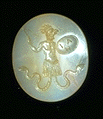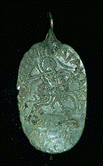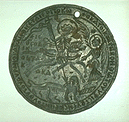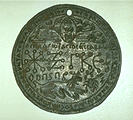 6. PMich inv. 6666 = PGM
CXXX
6. PMich inv. 6666 = PGM
CXXX
 6. PMich inv. 6666 = PGM
CXXX
6. PMich inv. 6666 = PGM
CXXX
Egypt
3rd century A.D.
Papyrus
Text:
This papyrus amulet, written in Greek, was folded (note the horizontal cracks), rolled, and carried by Helena in a small metallic tube, to protect her from the onslaught of fever. For the "iarbath" formula compare no. 17, and for the vowel-triangles -- a "squeezed" triangle on line 2 and a fully-developed one at the bottom -- compare nos. 16 and 40. Note also the star and the lunar crescent on the right.
Bibl.: R.W. Daniel, "P. Mich. Inv. 6666: Magic," Zeitschrift für Papyrologie und Epigraphik 50 (1983), pp. 147-154.
 7. PMich inv. 3023a
7. PMich inv. 3023a
Structure 113 I/Z, Karanis, Egypt
4th century A.D.?
Papyrus
Text: . . this amulet, akrammajamari aablanaphanalbaa. . . axeeeeeee [characteres] , Jesus, Jesus, great mind [. . . ], Jesus, Jesus, . . . Michael, Gabriel, . . . nuel.
A Coptic amulet, excavated in Karanis, Egypt, in a room whose contents date to the 3rd and 4th centuries A.D. Note the "akrammachamari" and "ablanathanalba" formulas (cf. nos. 4, 40, etc.), both slightly misspelled. For the characteres, cf. the notes to no. 10, and for their appearance in Christian amulets, cf. no. 32.
Bibl.: Meyer-Smith, no. 124.
Karanis, Egypt
3rd or 4th century A.D.?
Lead
A lead amulet, folded around the string with which it was worn, presumably around the wrist or ankle. Excavated in Karanis, Egypt, in a room whose contents date to the 3rd and 4th centuries A.D. It has never been unrolled, and its contents remain unknown.
Bibl.: Unpublished.
9. Kelsey Museum 29883-7
Iran or Iraq
5th to 7th century A.D.?
Lead
Lead amulets, written in Mandaic (an Eastern Aramaic dialect), on both sides. The texts have never been read.
Bibl.: Unpublished.
10. Kelsey Museum 26052
Purchased in Egypt
Lapis lazuli
 Obverse: Ouroboros enclosing
characteres.
Obverse: Ouroboros enclosing
characteres.
Reverse: Plain.
As on many other gems, the image is encircled by an ouroboros -- a snake devouring its own tail -- an Egyptian symbol of regeneration and eternity. The signs engraved on this gem were known in antiquity as characteres, and were considered very powerful. Their origin and meaning remain obscure, and seem to have been obscure to the ancient practitioners themselves. The commonest characteres have rings at their tips, but other forms are also found frequently, and new forms seem to have been created all the time, both due to corruption of existing forms through careless copying and due to deliberate innovation.
Bibl.: C. Bonner, Studies, no. 292.
11. Kelsey Museum 26059
Purchased in Egypt
Haematite
 Obv.: Two-headed god (snake and ibis heads), holding an
Egyptian was scepter and the ankh symbol. Below, a crocodile
with a disk on its back.
Obv.: Two-headed god (snake and ibis heads), holding an
Egyptian was scepter and the ankh symbol. Below, a crocodile
with a disk on its back.
Inscription: arpon chnouphi br[nta]tênôphiermioouth.
 Rev.: Inscrip.: iaeô baphrenemoun othilarikriphiae
u eaiphrikiralitho nuomenerphab ôeai phrikira. Digest! Digest!
(Chnoubis-sign) Chnoubis.
Rev.: Inscrip.: iaeô baphrenemoun othilarikriphiae
u eaiphrikiralitho nuomenerphab ôeai phrikira. Digest! Digest!
(Chnoubis-sign) Chnoubis.
A digestive amulet, which would be carried in a pouch, as close as possible to one's ailing stomach. Animal gods, and hybrid gods, were typical of the Egyptian pantheon and of its Greco-Roman adaptations, but the hybrid god on the obverse is not found elsewhere. The "arpon chnouphi" formula appears on other gems as well as in recipe books, and probably is of Egyptian origins ("Hor(us) - Khnoum..."). The obverse contains a slightly mutilated version of a well-known palindrome, "iaeôbaphrenemoun"-etc. (cf. the fine example in no. 40), as well as the command, "Digest,'' the divine name Chnoubis, and the zzz sign, which often accompanies Chnoubis' name.
Bibl.: C. Bonner, Studies, no. 264.
12. Kelsey Museum 26169
Purchased in Egypt
Gray agate
 Obv.: Cock-headed, snake-legged god, with a kilt, shield, and whip.
Obv.: Cock-headed, snake-legged god, with a kilt, shield, and whip.
Inscrip.: Iaô.
 Rev.: Inscrip.: tala araiô ôaraoro ntoko
nbai.
Rev.: Inscrip.: tala araiô ôaraoro ntoko
nbai.
The cock-headed, snake-legged god -- whose origins are unknown -- appears frequently on magical gems, often identified with Iaô. This gem might be a modern fake, modeled after a well-known ancient design. The meaningless inscription on the reverse may have been meant to sound like Coptic.
Bibl.: C. Bonner, Studies, no. 173.
13. Kelsey Museum 26054
Purchased in Egypt
Green jasper
 Obv.: Ouroboros enclosing cock-headed,
snake-legged god, with a military tunic, kilt, shield, and whip.
Obv.: Ouroboros enclosing cock-headed,
snake-legged god, with a military tunic, kilt, shield, and whip.
Inscrip.: (on shield) iaêio uôêiê êôiii; (above shield) Michaêl Rephaêl Gabriêl Ouriêl; (over whip) aieê; (below whip) sêmea kenteu konteu kengeu kêrideu darunkô lukuêxi; (under the snake legs) semeseilam lathramaphta iô iô iô iê iê iê iiiiiiiiiiii aêaêaê aaaiai eiô; (lower margin) psinôtherthernô.
 Rev.: Eagle-headed god wearing only an apron, calathus on head, six
wings, bird tail. In its hands, Egyptian sa amulets.
Rev.: Eagle-headed god wearing only an apron, calathus on head, six
wings, bird tail. In its hands, Egyptian sa amulets.
Inscrip.: asasam adouram.
Bevel: Seven scarab beetles, a star, a cynocephalus, a crocodile, and several obscure figures.
Note especially the international character of this gem -- the images are mostly Egyptian, the letters Greek, the god's dress is Roman, the angelic names (Michael, etc.) are Jewish, and some of the voces magicae (e.g. "semeseilam," which probably means "Eternal Sun") are of a Semitic, non-Jewish, origin. Note also the fine execution of every detail -- this gem took much time to produce, and must have cost accordingly.
Bibl.: C. Bonner, Studies, no. 172.
14. Kelsey Museum 26196
Origins unknown
Haematite
 Obv.: Cock(?)-headed, snake-legged god, with kilt, shield, and
whip.
Obv.: Cock(?)-headed, snake-legged god, with kilt, shield, and
whip.
On this gem, the snake-legged god was invoked to relieve indigestion.
Bibl.: C. Bonner, Studies, no. 185.
15. Kelsey Museum 26061
Purchased in Egypt
Green jasper
 Obv.: Osiris as mummy wearing the Egyptian atef crown,
between Isis and Nephthys, on a papyrus boat with hawks on each end.
Obv.: Osiris as mummy wearing the Egyptian atef crown,
between Isis and Nephthys, on a papyrus boat with hawks on each end.
 Rev.: Inscrip.: aeêiouô (surrounded by
meaningless hieroglyphics).
Rev.: Inscrip.: aeêiouô (surrounded by
meaningless hieroglyphics).
Whoever produced this gem was familiar with Egyptian iconography, as well as the appearance -- but not the meaning -- of Egyptian hieroglyphic signs. The seven Greek vowels were supposed to possess special power -- perhaps because they "breathe life," as it were, into dead consonants, and because Egyptians, whose writing systems provided no vowels, found them most intriguing -- and were "sung" aloud in numerous magical rituals.
Bibl.: C. Bonner, Studies, no. 2.
16. Kelsey Museum 26099
Purchased in Egypt
Green jasper
 Obv.: Pantheos figure with four wings, bird tail, a human face
wearing an Egyptian atef crown, and additional animal heads
project-ing sideways. Egyptian was scepters, and two birds.
Obv.: Pantheos figure with four wings, bird tail, a human face
wearing an Egyptian atef crown, and additional animal heads
project-ing sideways. Egyptian was scepters, and two birds.
 Rev.: Inscrip.: Iaô eulamô ieuêêu
a ee êêê iiii ooooo uuuuuu
ôôôôôôô.
Rev.: Inscrip.: Iaô eulamô ieuêêu
a ee êêê iiii ooooo uuuuuu
ôôôôôôô.
Pantheos figures -- hybrid deities incorporating the traits and forms of numerous gods -- are found in Egyptian iconography from before the Macedonian conquest in the 4th century B.C. and throughout the Greco-Roman period. For "eulamô," a common vox magica whose meaning is unknown, cf. no. 21. Note that the inscription on the reverse contains a "squeezed" vowel triangle (cf. no. 6).
Bibl.: C. Bonner, Studies, no. 254.
17. Kelsey Museum 26109
Purchased in Egypt
Haematite
 Obv.: Papyrus boat, with Harpocrates
sitting on a lotus, his head encircled by a nimbus with seven double rays.
Under his feet, a cynocephalus. Isis and Nephthys holding lotus scepters
and ankh symbols, wearing the Egyptian atef and
hemhem crowns. Triads of hawks, snakes, crocodiles, scarabs, and
goats. Two stars and two crescents.
Obv.: Papyrus boat, with Harpocrates
sitting on a lotus, his head encircled by a nimbus with seven double rays.
Under his feet, a cynocephalus. Isis and Nephthys holding lotus scepters
and ankh symbols, wearing the Egyptian atef and
hemhem crowns. Triads of hawks, snakes, crocodiles, scarabs, and
goats. Two stars and two crescents.
 Rev.: Scarab between two crowned hawks.
Rev.: Scarab between two crowned hawks.
Inscrip.: arbath agramnê phiblô chnêmeô.
Both obverse and reverse display typical Egyptian motifs, such as the gods sailing on the solar barque, or the sacred animals, symbols of individual deities. For the "(i)arbath" formula, cf. no. 6. The gold setting and suspension loop are modern.
Bibl.: C. Bonner, Studies, no. 210.
18. Kelsey Museum 26072
Purchased in Egypt
Green jasper
 Obv.: Ouroboros enclosing a seated Sarapis, with Cerberus
(?) at his feet. On his head, a winged scarab.
Obv.: Ouroboros enclosing a seated Sarapis, with Cerberus
(?) at his feet. On his head, a winged scarab.
 Rev.: Inscrip.: iaôanarabaranaôai
sthombaolê baol sthombalakamoth ombalê.
Rev.: Inscrip.: iaôanarabaranaôai
sthombaolê baol sthombalakamoth ombalê.
The inscription on the reverse contains one palindrome, which might be based on an Aramaic phrase meaning "I am the great Iaô," and the "sthombaolê" formula, found elsewhere.
Bibl.: C. Bonner, Studies, no. 17.
19. Kelsey Museum 26111
Purchased in Egypt
Bloodstone
 Obv.: The six-rayed characteres and an amphora with two
branches.
Obv.: The six-rayed characteres and an amphora with two
branches.
Inscrip.: euthem.
Rev.: Plain.
The amphora-and-branches design was a common symbol of prosperity. The meaning of the inscription is unclear.
Bibl.: C. Bonner, Studies, no. 273.
20. Kelsey Museum 26067
Purchased in Egypt
Haematite
 Obv.: Ouroboros enclosing uterine symbol, with Khnoum, the
ram-headed god touching the knob of the key. Above, Isis and
Nephthys flanking Anubis and an unidentified figure (the patient?).
Obv.: Ouroboros enclosing uterine symbol, with Khnoum, the
ram-headed god touching the knob of the key. Above, Isis and
Nephthys flanking Anubis and an unidentified figure (the patient?).
Inscrip.: (inside ouroboros) iariaiaiiieôiô Sabaôth êi (outside) soroor merpher ga[rmar maphreiour]igx.
 Rev.: Ouroboros, enclosing inscription,
characteres, and
Chnoubis symbol. Inscrip.: orôriouth
iaêôiaô (3 characteres?) Sabaôth
(character) iaêôieai borbor parphor phorbar
phorphor
rai.
Rev.: Ouroboros, enclosing inscription,
characteres, and
Chnoubis symbol. Inscrip.: orôriouth
iaêôiaô (3 characteres?) Sabaôth
(character) iaêôieai borbor parphor phorbar
phorphor
rai.
A uterine amulet, meant to control contraception and childbirth by "opening" and "closing" the womb with its special "key." On such amulets, the uterus-scene often is accompanied by "orôriouth" which must be the name of the power which controls uterine activities (or of the uterus itself), and by the "sororoor" formula, whose meaning and function remain unknown. Note the appearance of the Jewish divine name Sabaôth ("(Lord of) Hosts") amidst the Egyptian iconography.
Bibl.: C. Bonner, Studies, no. 142.
21. Kelsey Museum 26050
Purchased in Egypt
Rock crystal
Inscrip.: Iaô eulamô Abrasax.
Rev.: Plain.
For "Iaô eulamô," cf. no. 16; for Abrasax, cf. no. 3.
Bibl.: C. Bonner, Studies, no. 237.
22. Kelsey Museum 26091
Purchased in Egypt
Glass paste?
Obv.: A rectangular prism, inscribed on all four sides.
Inscrip.:
Note the longitudinal perforation, for a cord to go through. While Iaô, Sabaô(th), and Michaêl are of Jewish origins, Thôth is an Egyptian god, usually equated with the Greek god Hermes, and in some cases even with the bibl ical Moses.
Bibl.: C. Bonner, Studies, no. 361.
23. Kelsey Museum 26121
Purchased in Syria
Haematite
 Obv.: Reaper cutting stalks of grain. Tree behind him, snake below.
Obv.: Reaper cutting stalks of grain. Tree behind him, snake below.
Inscrip.: For the hips.
An amulet against hip pains (sciatica). The reaper imagery must have been chosen for this well-attested type of amulet because of the agricultural laborer's perceived immunity to hip- and back-ache.
Bibl.: C. Bonner, Studies, no. 123.
24. Kelsey Museum 26153
Purchased in Syria
Sard
Inscrip.: Salamaxa (three characteres) bameaza.
Rev.: Plain.
Note the perforation. The meaning of the voces magicae, probably of Semitic origin, is unknown.
Bibl.: C. Bonner, Studies, no. 286.
25. Kelsey Museum 26125
Purchased in Syria
Staetite
 Obv.: Ouroboros?, enclosing an unidentified figure, holding an
unidentified object towards a large snake. Between them, a small
altar?
Obv.: Ouroboros?, enclosing an unidentified figure, holding an
unidentified object towards a large snake. Between them, a small
altar?
The script on the reverse has not been identified. It may be a pseudo-script or a cipher, but more probably it is a real, as yet unidentified, alphabet.
Bibl.: C. Bonner, Studies, no. 340.
26. Kelsey Museum 26129
Purchased in Syria
Lead
Note the suspension loops -- this amulet was made to be hung, presumably around the neck. Note that both sides are written in mirror-letters -- apparently this, too, was thought to increase the amulet's efficacy.
Bibl.: C. Bonner, Studies, no. 342.
27. Kelsey Museum 26092
Purchased in Egypt
Haematite
 Obv.: Rider spearing a prostrate female demon.
Obv.: Rider spearing a prostrate female demon.
Inscrip.: Solomon.
Inscrip.: Seal of God.
Rider-amulets such as this one were popular, possibly among Jews and certainly among Christians as all-purpose protective devices. The imagery -- a mounted warrior subduing a prostrate enemy -- is common enough in many cultures, and its adoption as a symbol in the fight against demons is readily understandable. On this amulet, as on many others, the rider is identified as Solomon, the wise biblical king whom post-biblical traditions turned into an expert in all occult sciences, and especially the subjugation of demons. Thus, Jews and Christians alike invoked Solomon's name in exorcism rituals, and told stories of the wonderful seal with which he "muzzled" and "sealed" every evil spirit. On this amulet the key, like God's seal, symbolizes the power to shut the demons in and prevent them from doing any harm.
Bibl.: C. Bonner, Studies, no. 294.
28. Kelsey Museum 26140
Purchased in Syria
Haematite
 Obv.: Rider spearing a prostrate demon.
Obv.: Rider spearing a prostrate demon.
Bibl.: C. Bonner, Studies, pp. 208-210.
29. Kelsey Museum 26114
Purchased in Syria
Bronze
 Obv.: Rider with nimbus, spearing a prostrate (female) demon.
Obv.: Rider with nimbus, spearing a prostrate (female) demon.
Inscrip.: One God, who conquers ev(il).
Inscrip.: Iaôth, Sabaôth, Michaêl.
On the obverse, the engraver forgot the last two letters of the word "evil." Note also the erroneous spelling Iaôth, clearly influenced by Sabaôth. The "One God" invocation -- here coupled with the powerful names Iaô, Sabaôth, and Michaêl -- appears often on this type of amulet.
Bibl.: C. Bonner, Studies, no. 309.
30. Kelsey Museum 26115
Purchased in Syria
Bronze
 Obv.: Rider with nimbus, spearing a prostrate female demon. Below, a lion.
Obv.: Rider with nimbus, spearing a prostrate female demon. Below, a lion.
Inscrip.: One God who conquers evil.
 Rev.: The "evil eye" design -- a human eye, attacked by a lion,
an ibis, a snake, a scorpion, a leopard?, a trident, and a spear.
Rev.: The "evil eye" design -- a human eye, attacked by a lion,
an ibis, a snake, a scorpion, a leopard?, a trident, and a spear.
Inscrip.: Iaô Sabaôth Michael, help.
Here the rider-motif is coupled with the so-called "evil eye." Throughout the ancient world, the notion prevailed that a person's envious or malicious glance at other persons, or at their property, can cause them much damage. To protect against this effect, the drawing of such an "evil eye," attacked by various monsters and weapons, was considered especially effective. The "evil eye" design was an extremely popular apotropaic (protective) device, appearing not only on amulets but on mosaics and other forms of artistic expression as well.
Bibl.: C. Bonner, Studies, no. 299.
31. Kelsey Museum 26165
Purchased in Syria
Bronze
 Obv.: Rider with nimbus, spearing a prostrate demon.
Inscrip.:
ogurak mareot ufzezo uzerbe.
Obv.: Rider with nimbus, spearing a prostrate demon.
Inscrip.:
ogurak mareot ufzezo uzerbe.
Rev.: Plain.
Bezel of a ring, hoop broken away. The meaning of the inscription -- if it is not merely gibberish -- is unknown.
Bibl.: C. Bonner, Studies, no. 323.
32. Kelsey Museum 26119
Purchased in Syria
Bronze
 Obv.: Rider with nimbus spearing a lioness with a human, female
face. An angel with nimbus blesses the rider with his raised wing.
Obv.: Rider with nimbus spearing a lioness with a human, female
face. An angel with nimbus blesses the rider with his raised wing.
Inscrip.: (in field) One God who conquers evil; (in margin) (cross) He who dwells in the help of the Most High will abide in the shelter of the God of heaven. He will say to the Lord...
 Rev.: Above: Christ enthroned, surrounded by the four animals
of the Apocalypse -- an ox, a man, an eagle and a lion. Below: A lion, a snake, two cobras?, and a crab.
Rev.: Above: Christ enthroned, surrounded by the four animals
of the Apocalypse -- an ox, a man, an eagle and a lion. Below: A lion, a snake, two cobras?, and a crab.
Inscrip.: (in field) Holy, Holy, Holy, Lord Sabaôth (characteres); (in margin) (cross) The seal of th e living God, Guard from every evil him who carries this amulet.
Note the cross on the tip of rider's spear, and the crosses at the beginning of the marginal inscriptions. The "He who dwells" formula is the first verse of Psalm 91, a hymn stressing God's protection of the pious, which was extremely popular as a protective incantation in Jewish and Christian amulets. Psalm 91's explicit mention of the lion, the asp, the cobra, and the snake as monsters of whom the pious will know no fear could explain their appearance -- with a crab substituting for the asp -- on this amulet. Note especially the characteres, so popular in pre-Christian magic, which are here incorporated into an otherwise Christian image (cf. no. 7).
Bibl.: C. Bonner, Studies, no. 324.
Purchased in Syria
Bronze
A bracelet with four medallions (the fifth would have been glued under the first).
 A. Inscrip.: He who dwells in the help.
A. Inscrip.: He who dwells in the help.
 B. The Virgin with the Child, and one of the Magi?
B. The Virgin with the Child, and one of the Magi?
 C. The women at the empty tomb?
C. The women at the empty tomb?
 D. Rider with nimbus spearing a prostrate demon.
D. Rider with nimbus spearing a prostrate demon.
This bracelet displays some well known motifs of Christian amulets, such as Psalm 91(cf. no. 32) and the rider (cf. nos. 27-32), as well as New Testament scenes which were thought to protect the wearer from harm.
Bibl.: C. Bonner, Studies, no. 321.
Go on to Protective Magic 2: Babylonian Demon Bowls.